A Multi-Year Investigation of Thunderstorm Activity at Istanbul International Airport Using Atmospheric Stability Indices
Abstract
1. Introduction
2. Data and Methodology
2.1. Study Area
2.2. Data
2.3. Methodology
3. Results
3.1. Thunderstorm Statistics
3.2. Upper Atmosphere Variables
3.3. Thunder Storm Stability Indices
3.3.1. Total Totals Index
3.3.2. K Index
3.4. Stability Indices for Non-TS Situations
3.4.1. Total Totals Index
3.4.2. K Index
3.5. Effective Stability Indices During Extreme Cases
- -
- The total totals index (TT) showed a significant increase and exceeded 55, indicating a high probability of severe thunderstorm events. This coincides with the peak of storm activity in June with 32 events.
- -
- The K index also showed an increasing trend and exceeded 35 on the days of the most severe thunderstorm events.
- -
- The total totals index (TT) remained stable above 50 throughout the thunderstorm event, reflecting how the sea influence affected this situation.
- -
- The K index gradually increased and reached 38 on the day of the strongest storm.
- -
- Total totals index (TT) showed a sharp increase above 50, coinciding with a sudden increase in thunderstorm event activity.
- -
- K index also showed a notable increase, exceeding 30 on the days when thunderstorm events occurred.
4. Discussion
5. Conclusions
Author Contributions
Funding
Institutional Review Board Statement
Informed Consent Statement
Data Availability Statement
Acknowledgments
Conflicts of Interest
References
- National Weather Service. Thunderstorm Hazards. National Weather Service, 2019. Available online: https://www.weather.gov/jetstream/thunderstorms (accessed on 1 June 2023).
- Ahrens, C.D. Meteorology Today: An Introduction to Weather, Climate, and the Environment; Cengage Learning: Boston, MA, USA, 2019. [Google Scholar]
- NOAA. Supercells and Severe Storms. National Weather Service, 2020. Available online: https://www.weather.gov/jetstream/supercells (accessed on 1 June 2023).
- National Transportation Safety Board (NTSB). Weather-Related Aviation Accidents. NTSB, 2019. Available online: https://www.ntsb.gov (accessed on 1 June 2023).
- International Civil Aviation Organization. Thunderstorms and Lightning Safety. ICAO, 2020. Available online: https://www.icao.int (accessed on 1 June 2023).
- National Weather Service. Aviation and Weather Hazards. National Weather Service, 2021. Available online: https://www.weather.gov (accessed on 1 June 2023).
- Long, T. Analysis of Weather-Related Accident and Incident Data Associated with Section 14 CFR Part 91 Operations. Coll. Aviat. Rev. Int. 2022, 40. Available online: https://ojs.library.okstate.edu/osu/index.php/CARI/article/view/8442 (accessed on 1 June 2023). [CrossRef]
- Doswell, C.A.; Brooks, H.E.; Kay, M.P. Climatological Estimates of Daily Local Nontornadic Severe Thunderstorm Probability for the United States. Weather. Forecast. 2005, 20, 577–595. [Google Scholar] [CrossRef]
- Tyagi, A. Thunderstorm climatology over Indian region. Mausam 2007, 58, 189–212. [Google Scholar] [CrossRef]
- Mohee, F.; Miller, C. Climatology of Thunderstorms for North Dakota, 2002–2006. J. Appl. Meteorol. Clim. 2010, 49, 1881–1890. [Google Scholar] [CrossRef]
- Brimelow, J.C.; Reuter, G.W.; Bellon, A.; Hudak, D. A radar-based methodology for preparing a severe thunderstorm climatology in central Alberta. Atmos. Ocean. 2004, 42, 13–22. [Google Scholar] [CrossRef]
- Singh, C.; Mohapatra, M.; Bandyopadhyay, B.; Tyagi, A. Thunderstorm climatology over northeast and adjoining east India. Mausam 2011, 62, 163–170. [Google Scholar] [CrossRef]
- Allen, J.; Karoly, D.; Mills, G. A severe thunderstorm climatology for Australia and associated thunderstorm environments. Aust. Meteorol. Oceanogr. J. 2011, 61, 143–158. [Google Scholar] [CrossRef]
- Deniz, A.; Özdemir, E.T.; Sezen, I.; Coşkun, M. Investigations of storms in the region of Marmara in Turkey. Theor. Appl. Clim. 2013, 112, 61–71. [Google Scholar] [CrossRef]
- Allen, J.T.; Karoly, D.J. A climatology of Australian severe thunderstorm environments 1979-2011: Inter-annual variability and ENSO influence. Int. J. Clim. 2013, 34, 81–97. [Google Scholar] [CrossRef]
- Haberlie, A.M.; Ashley, W.S.; Pingel, T.J. The effect of urbanisation on the climatology of thunderstorm initiation. Q. J. R. Meteorol. Soc. 2015, 141, 663–675. [Google Scholar] [CrossRef]
- Cecil, D.J.; Buechler, D.E.; Blakeslee, R.J. TRMM-LIS Climatology of Thunderstorm Occurrence and Conditional Lightning Flash Rates. J. Clim. 2015, 28, 6536–6547. [Google Scholar] [CrossRef]
- Pinto, O. Thunderstorm climatology of Brazil: ENSO and Tropical Atlantic connections. Int. J. Climatol. 2014, 35, 871–878. [Google Scholar] [CrossRef]
- Özdemir, E.T.; Deniz, A. Severe thunderstorm over Esenboğa International Airport in Turkey on 15 July 2013. Weather 2016, 71, 157–161. [Google Scholar] [CrossRef]
- Ozdemir, E.T.; Deniz, A.; Sezen, I.; Aslan, Z.; Yavuz, V. Investigation of Thunderstorms over Ataturk International Airport (LTBA), Istanbul. Mausam 2017, 68, 175–180. [Google Scholar] [CrossRef]
- Sirdas, S.A.; Özdemir, E.T.; Sezen, I.; Efe, B.; Kumar, V. Devastating extreme Mediterranean cyclone’s impacts in Turkey. Nat. Hazards 2017, 87, 255–286. [Google Scholar] [CrossRef]
- Taszarek, M.; Allen, J.; Púčik, T.; Groenemeijer, P.; Czernecki, B.; Kolendowicz, L.; Lagouvardos, K.; Kotroni, V.; Schulz, W. A Climatology of Thunderstorms across Europe from a Synthesis of Multiple Data Sources. J. Clim. 2019, 32, 1813–1837. [Google Scholar] [CrossRef]
- Galanaki, E.; Lagouvardos, K.; Kotroni, V.; Flaounas, E.; Argiriou, A. Thunderstorm climatology in the Mediterranean using cloud-to-ground lightning observations. Atmos. Res. 2018, 207, 136–144. [Google Scholar] [CrossRef]
- Dowdy, A.J. Climatology of thunderstorms, convective rainfall and dry lightning environments in Australia. Clim. Dyn. 2020, 54, 3041–3052. [Google Scholar] [CrossRef]
- Hayward, L.; Whitworth, M.; Pepin, N.; Dorling, S. A comprehensive review of datasets and methodologies employed to produce thunderstorm climatologies. Nat. Hazards Earth Syst. Sci. 2020, 20, 2463–2482. [Google Scholar] [CrossRef]
- Yavuz, V.; Deniz, A.; Özdemir, E.T.; Karan, H.; Temiz, C. Long-term thunderstorm analysis at airports in the Marmara Region: Types and favourable atmospheric conditions. Int. J. Glob. Warm. 2022, 28, 81–95. [Google Scholar] [CrossRef]
- DiGangi, E.A.; Stock, M.; Lapierre, J. Thunder Hours: How Old Methods Offer New Insights into Thunderstorm Climatology. Bull. Amer. Meteor. Soc. 2022, 103, E548–E569. [Google Scholar] [CrossRef]
- Kunz, M. The skill of convective parameters and indices to predict isolated and severe thunderstorms. Nat. Hazards Earth Syst. Sci. 2007, 7, 327–342. [Google Scholar] [CrossRef]
- Haklander, A.J.; Van Delden, A. Thunderstorm predictors and their forecast skill for the Netherlands. Atmos. Res. 2003, 67, 273–299. [Google Scholar] [CrossRef]
- Rasmussen, E.N.; Blanchard, D.O. A Baseline Climatology of Sounding-Derived Supercell and Tornado Forecast Parameters. Wea. Forecast. 1998, 13, 1148–1164. [Google Scholar] [CrossRef]
- Doswell, C.A.; Schultz, D.M. On the use of indices and parameters in forecasting severe storms. Electron. J. Sev. Storms Meteor. 2006, 1, 1–22. [Google Scholar] [CrossRef]
- İBB (İstanbul Büyükşehir Belediyesi). 2024. Available online: https://ibb.istanbul/ (accessed on 14 December 2024).
- Tayanc, M. An assessment of spatial and temporal variation of sulfur dioxide levels over Istanbul, Turkey. Environ. Pollut. 2000, 107, 61–69. [Google Scholar] [CrossRef]
- DHMİ (Devlet Hava Meydanları İşletmesi). 2024. Available online: https://www.dhmi.gov.tr/sayfalar/havalimani/istanbul/GenelBilgiler.aspx (accessed on 12 December 2024).
- Istanbul Airport. 2024. Available online: https://www.istairport.com/kurumsal/hakkimizda/ (accessed on 12 December 2024).
- IST (Istanbul International Airport). 2024. Available online: https://istanbul-international-airport.com/ (accessed on 12 December 2024).
- SHGM (Sivil Havacılık Genel Müdürlüğü). 2024. Available online: https://web.shgm.gov.tr/ (accessed on 12 December 2024).
- Vujović, D.; Paskota, M.; Todorović, N.; Vučković, V. Evaluation of the stability indices for the thunderstorm forecasting in the region of Belgrade, Serbia. Atmos. Res. 2015, 161–162, 143–152. [Google Scholar] [CrossRef]
- Viceto, C.; Marta-Almeida, M.; Rocha, A. Future climate change of stability indices for the Iberian Peninsula. Int. J. Climatol. 2017, 37, 4390–4408. [Google Scholar] [CrossRef]
- Showalter, A.K. A stability index for forecasting thunderstorms. Bull. Am. Meteorol. Soc. 1953, 34, 250–252. [Google Scholar] [CrossRef]
- Peppler, R.A.; Lamb, P.J. Tropospheric static stability and central North American growing season rainfall. Mon. Weather. Rev. 1989, 117, 1156–1180. [Google Scholar] [CrossRef]
- Miler, R.C. Notes on Analysis and Severe Storm Forecasting Procedures of the Air Force Global Weather Central; Air Weather Service: Asheville, NC, USA, 1972.
- Ackerman, S.A.; Knox, J. Meteorology: Understanding the Atmosphere; Jones & Bartlett Publishers: Burlington, MA, USA, 2011; pp. 339–379. [Google Scholar]
- NSW Glossary (National Weather Service Glossary). National Weather Service Glossary. 2024. Available online: https://forecast.weather.gov/glossary.php? (accessed on 15 December 2024).
- ATPL Ground Training Series. Meteorology; CAE Oxford Aviation Academy (UK) Limited: Kidlington, UK, 2014; p. 46. [Google Scholar]
- Wetter3. 2024. Available online: https://www.wetter3.de/ (accessed on 15 December 2024).
- Wickham, H. ggplot2: Elegant Graphics for Data Analysis; Springer: New York, NY, USA, 2016. [Google Scholar]
- R Core Team. R: A Language and Environment for Statistical Computing; R Foundation for Statistical Computing: Vienna, Austria, 2023; Available online: https://www.R-project.org/ (accessed on 20 November 2024).
- Wickham, H.; Francois, R.; Henry, L.; Muller, K.; Vaughan, D. dplyr: A Grammar of Data Manipulation. 2023. R package version 1.1.2. Available online: https://CRAN.R-project.org/package=dplyr (accessed on 20 November 2024).
- Brooks, H.E.; Lee, J.W.; Craven, J.P. The spatial distribution of severe thunderstorm and tornado environments from global reanalysis data. Atmos. Res. 2003, 67, 73–94. [Google Scholar] [CrossRef]
- Weisman, M.L.; Klemp, J.B. The dependence of numerically simulated convective storms on vertical wind shear and buoyancy. Mon. Weather. Rev. 1982, 110, 504–520. [Google Scholar] [CrossRef]
- Taszarek, M.; Brooks, H.E.; Czernecki, B. Sounding derived parameters associated with convective hazards in Europe. Mon. Weather. Rev. 2017, 145, 1511–1528. [Google Scholar] [CrossRef]

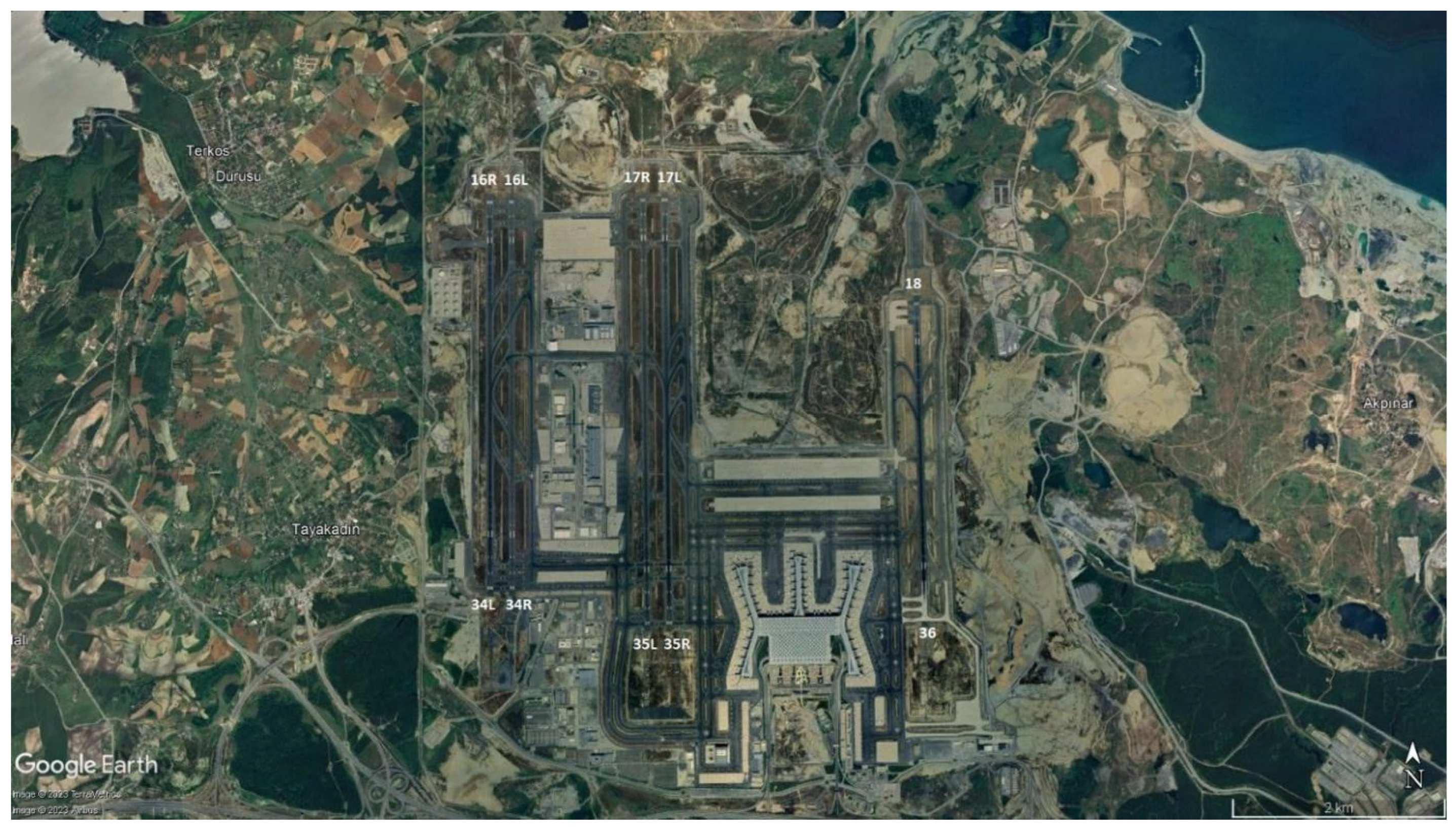

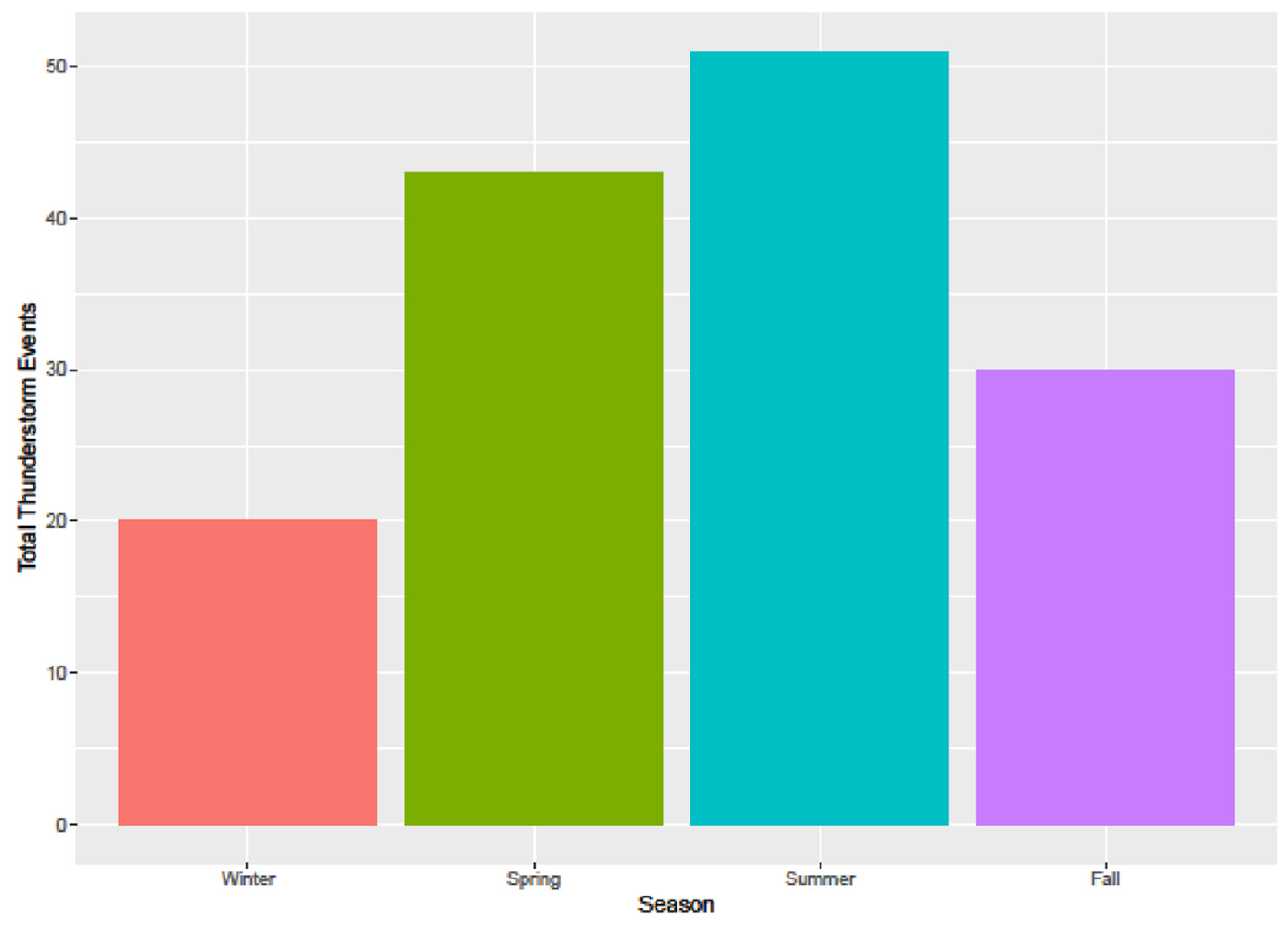


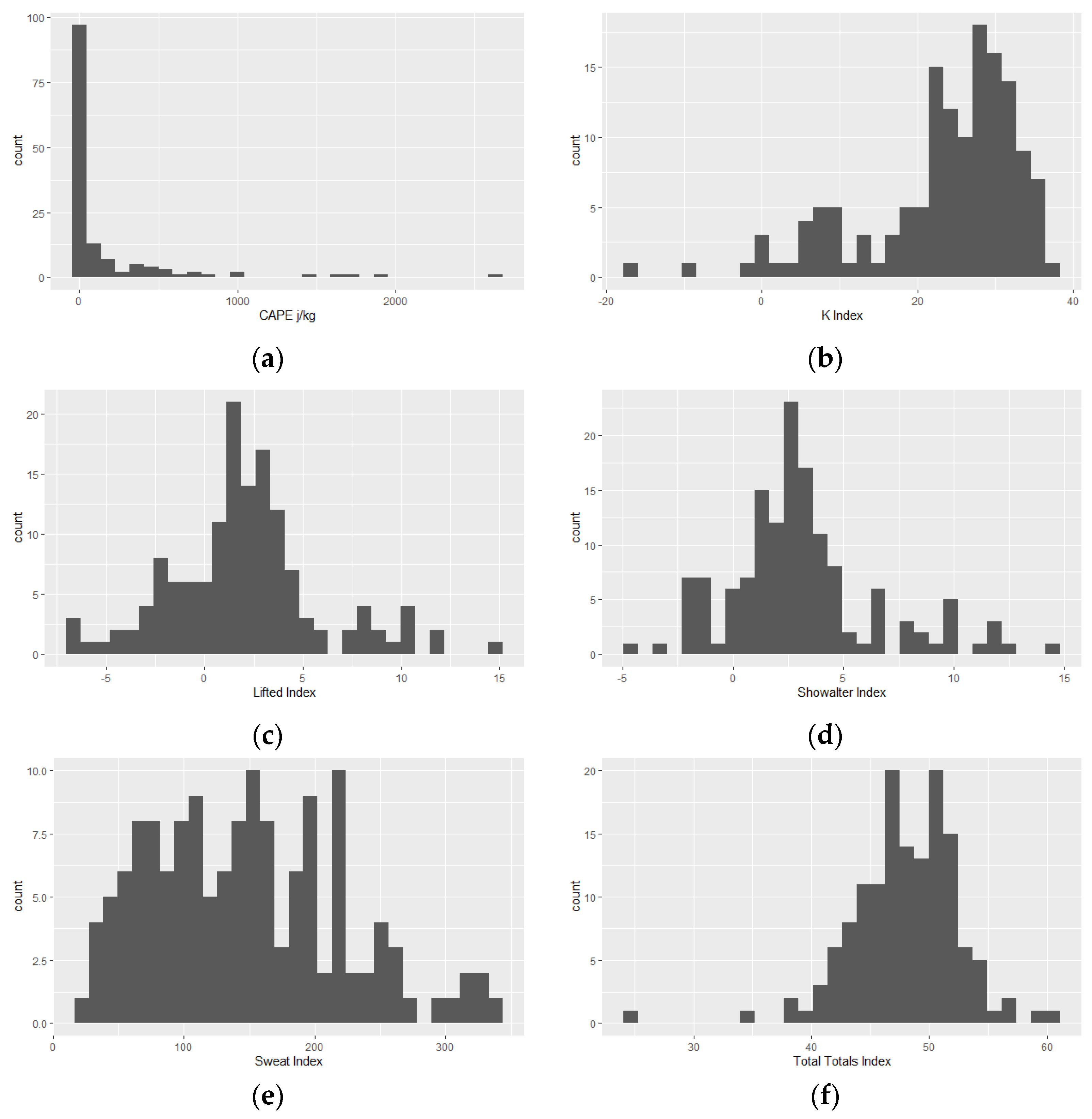
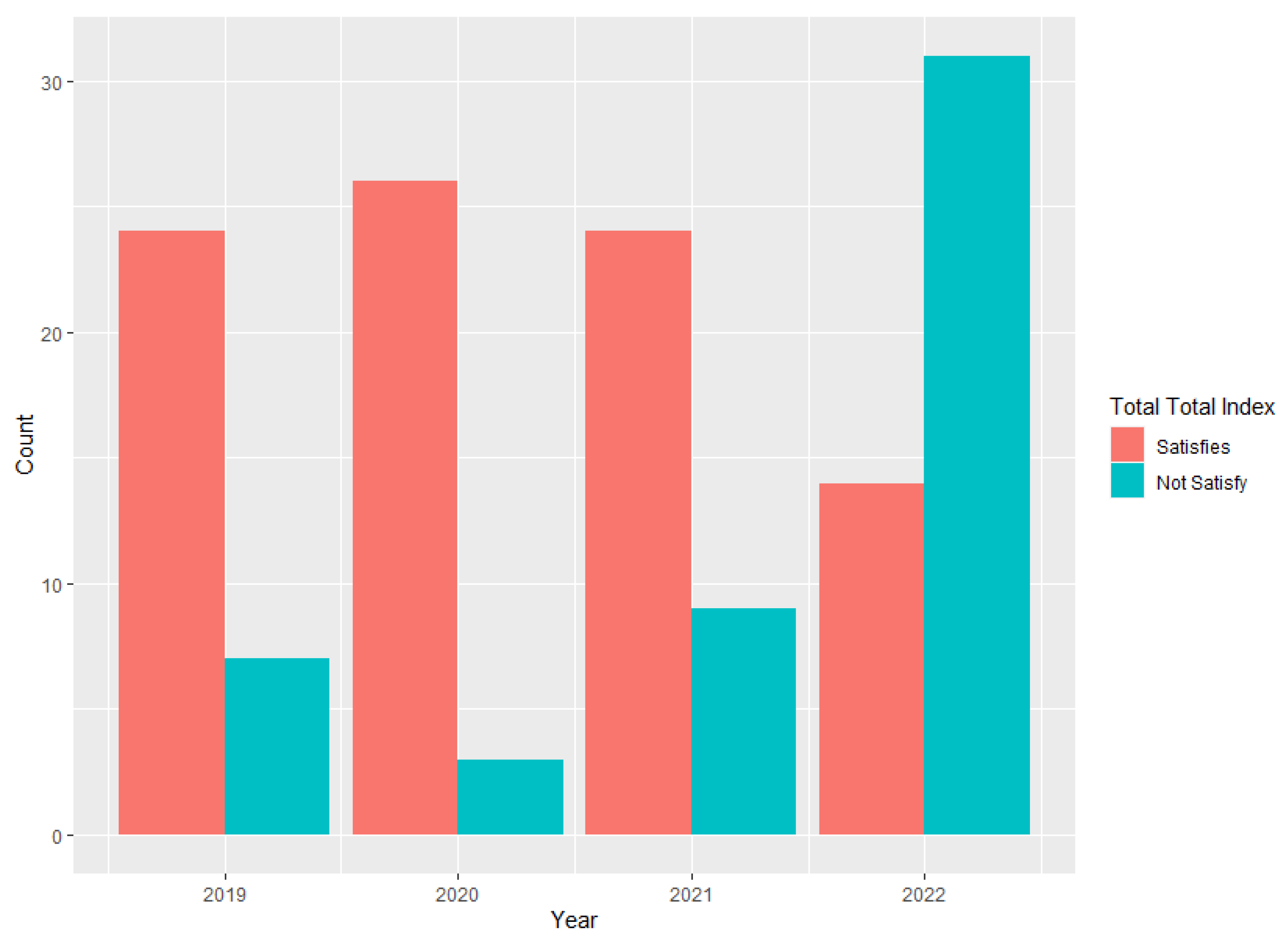

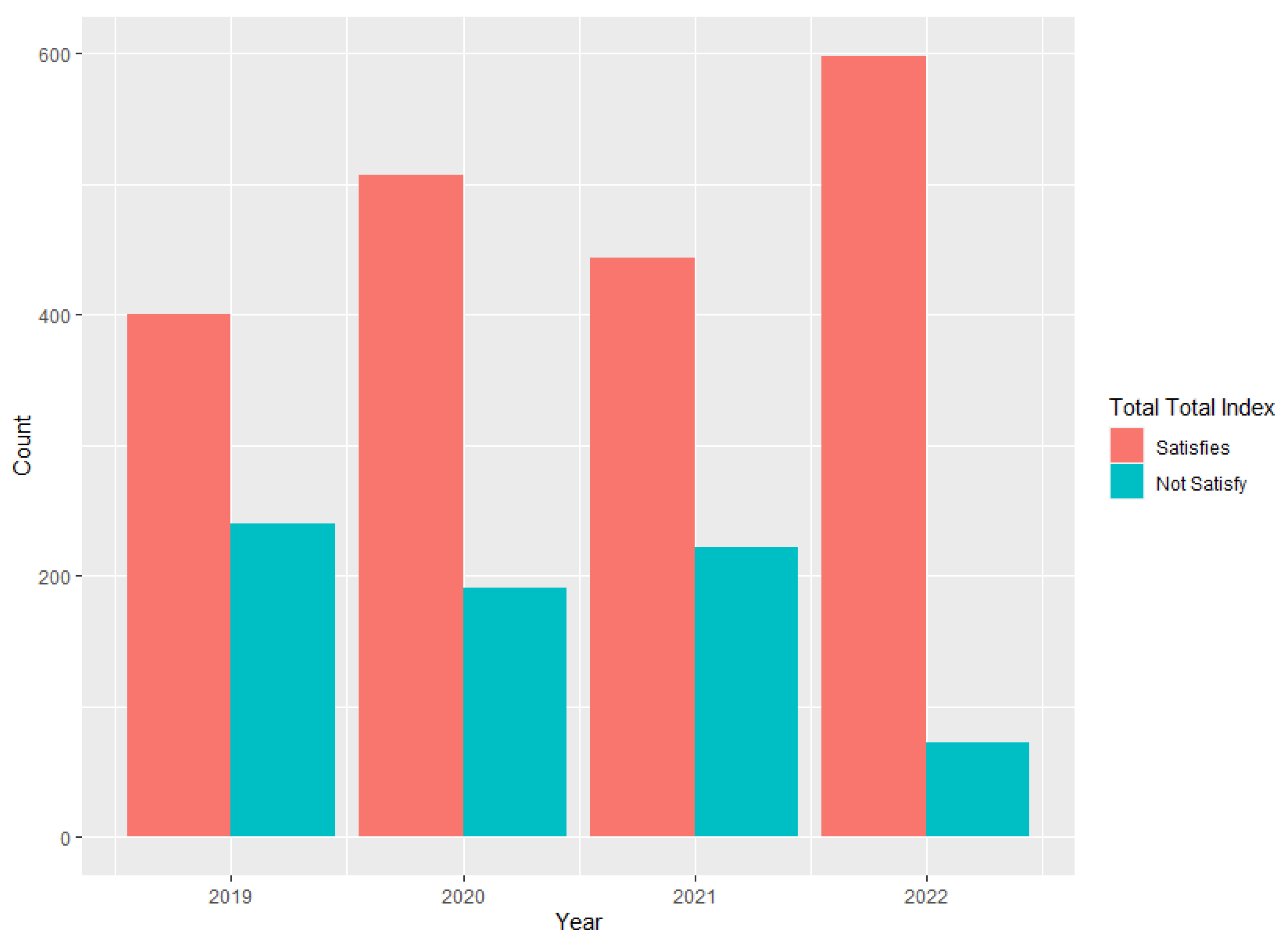
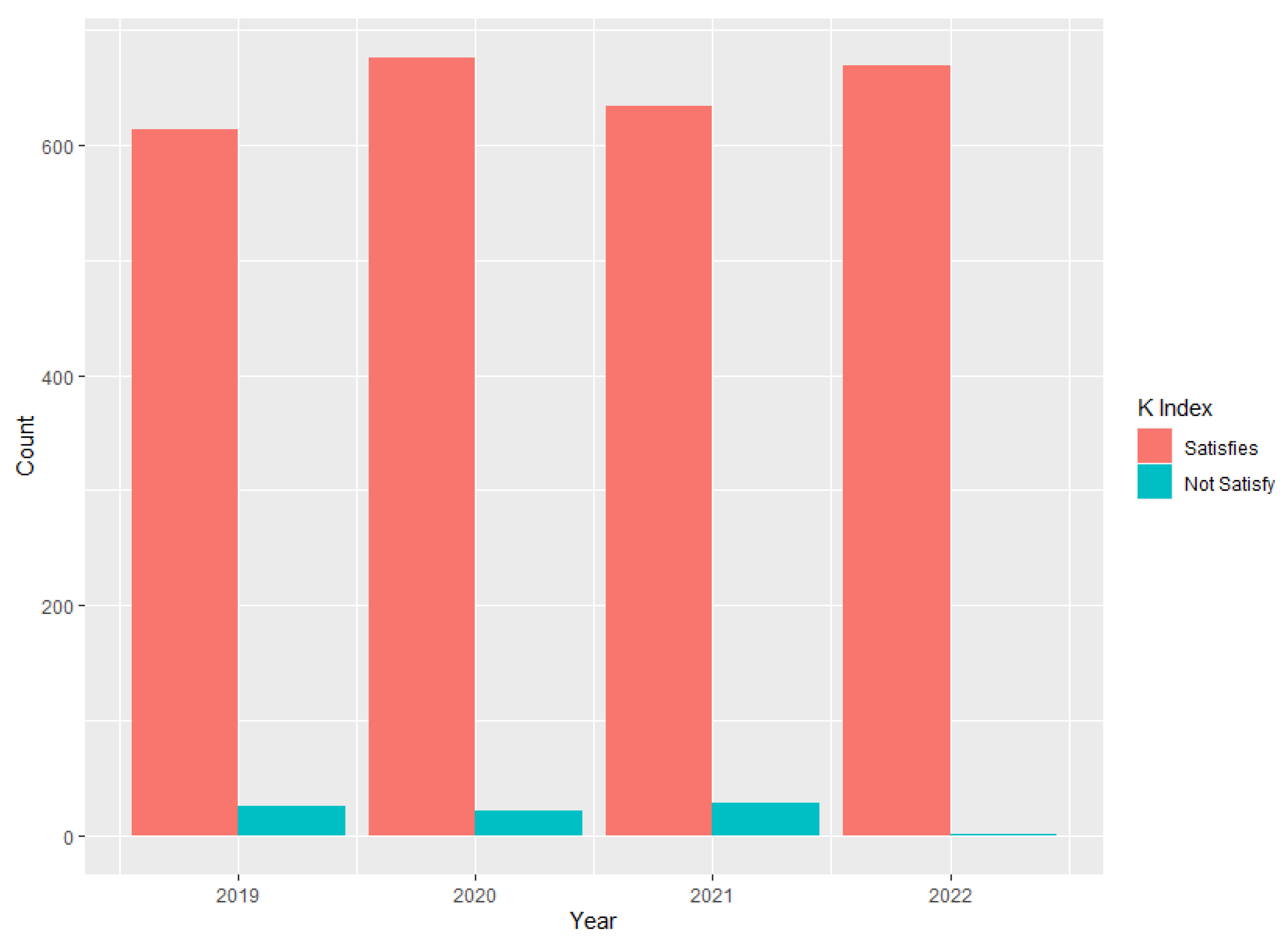
| Index Name | Calculation | Critique Values |
|---|---|---|
| 0 to −3: Moderately unstable; −3 to −6: Very unstable; SI < −6: Extremely unstable | ||
| −3 to −6: Moderately unstable; −6 to −9: Very unstable; SI < −9: Extremely unstable | ||
| SWEAT over 300: Potential for severe thunderstorms; SWEAT over 400: Potential for tornadoes. | ||
| K over 30: Better potential for thunderstorms with heavy rain. K = 40: Best potential for thunderstorms with very heavy rain. | ||
| TT = 45 to 50: Thunderstorms possible; TT = 50 to 55: Thunderstorms more likely, possibly severe. TT = 55 to 60: Severe thunderstorms most likely. | ||
| CAPE = 1000 to 2500: Moderately unstable; CAPE = 2500 to 3500: Very unstable. CAPE above 3500–4000: Extremely unstable. |
| 2019 | 2020 | 2021 | 2022 | |
|---|---|---|---|---|
| January | - | - | 2 | 6 |
| February | - | 2 | 1 | 3 |
| March | 1 | - | 4 | 10 |
| April | 3 | 1 | 1 | 4 |
| May | 8 | 6 | 3 | 2 |
| June | 7 | 12 | 9 | 4 |
| July | 5 | - | 2 | 2 |
| August | 4 | 1 | - | 5 |
| September | 1 | 1 | 4 | 6 |
| October | 1 | 6 | 2 | 1 |
| November | 3 | - | 3 | 2 |
| December | 3 | - | 3 | - |
Disclaimer/Publisher’s Note: The statements, opinions and data contained in all publications are solely those of the individual author(s) and contributor(s) and not of MDPI and/or the editor(s). MDPI and/or the editor(s) disclaim responsibility for any injury to people or property resulting from any ideas, methods, instructions or products referred to in the content. |
© 2025 by the authors. Licensee MDPI, Basel, Switzerland. This article is an open access article distributed under the terms and conditions of the Creative Commons Attribution (CC BY) license (https://creativecommons.org/licenses/by/4.0/).
Share and Cite
Kolay, O.; Efe, B.; Özdemir, E.T.; Aslan, Z. A Multi-Year Investigation of Thunderstorm Activity at Istanbul International Airport Using Atmospheric Stability Indices. Atmosphere 2025, 16, 470. https://doi.org/10.3390/atmos16040470
Kolay O, Efe B, Özdemir ET, Aslan Z. A Multi-Year Investigation of Thunderstorm Activity at Istanbul International Airport Using Atmospheric Stability Indices. Atmosphere. 2025; 16(4):470. https://doi.org/10.3390/atmos16040470
Chicago/Turabian StyleKolay, Oğuzhan, Bahtiyar Efe, Emrah Tuncay Özdemir, and Zafer Aslan. 2025. "A Multi-Year Investigation of Thunderstorm Activity at Istanbul International Airport Using Atmospheric Stability Indices" Atmosphere 16, no. 4: 470. https://doi.org/10.3390/atmos16040470
APA StyleKolay, O., Efe, B., Özdemir, E. T., & Aslan, Z. (2025). A Multi-Year Investigation of Thunderstorm Activity at Istanbul International Airport Using Atmospheric Stability Indices. Atmosphere, 16(4), 470. https://doi.org/10.3390/atmos16040470









